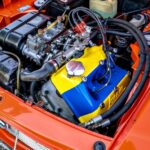The clutch, positioned strategically between your vehicle’s engine and gearbox, is a fundamental component in manual transmission cars. It serves as the crucial mechanical link that transmits power from the engine to the wheels, enabling you to drive. For decades, regardless of whether you’re behind the wheel of an American muscle car, a Korean sedan, or a German hatchback, the basic clutch system has remained remarkably consistent. This standardization highlights its essential role in the driving experience we know today.
The primary function of the clutch is to manage the connection between the engine and the gearbox. It’s the system responsible for engaging and disengaging engine power, allowing for smooth gear changes and controlled power delivery to the wheels. Let’s delve deeper into understanding this vital car part and explore its workings.
Defining the Clutch in Automotive Terms
In simple terms, the clutch definition car users often search for can be stated as: a mechanism that facilitates the precise transmission of power from the engine to the gearbox, which subsequently drives the car’s wheels. Essentially, the clutch’s purpose is to seamlessly connect and disconnect the engine’s rotational force from the gear system.
In vehicles equipped with a manual transmission, the clutch pedal is a vital control. Operated by the driver’s left foot, it’s positioned to the left of the brake pedal. Conversely, automatic transmission cars typically eliminate the clutch pedal altogether, simplifying driving to just the brake and accelerator pedals.
When you examine the components of a typical clutch system, you’ll find several key parts:
- Flywheel: This is a substantial, circular component that rotates in sync with the engine’s operation. It provides a rotating surface for the clutch to engage with.
- Clutch Disc (Friction Disc): Also known as the friction disc, this part is layered with a specialized friction material, similar to brake pad material, on both sides. This material is crucial for creating friction and enabling power transfer.
- Pressure Plate (Clutch Cover): This component is bolted to the flywheel and applies pressure to the clutch disc, engaging it with the flywheel.
- Release Fork (Pusher Fork): The release fork is the lever that applies pressure to the clutch diaphragm spring or release bearing, initiating clutch disengagement.
For a more in-depth exploration of these individual clutch components and their specific locations within the system, further resources detailing types of clutches and their parts are available.
The Purpose of the Clutch System
As previously mentioned, the core purpose of the mechanical clutch system is to manage the power flow from the engine to the gearbox. It allows for the disconnection and reconnection of this power, which is essential for manual gear changes and for absorbing vibrations and shocks from the drivetrain.
When a gear is engaged and the clutch is engaged, power flows smoothly to the wheels, propelling the vehicle. However, when the clutch pedal is depressed to shift gears (upshifting or downshifting), the clutch disengages. In this disengaged state, the wheels are effectively disconnected from the engine and can rotate freely. There’s also an intermediate stage during clutch operation, often referred to as the “friction zone,” which helps to cushion the engagement and disengagement, protecting the engine and gearbox from sudden shocks.
How a Clutch Operates in Your Car: A Detailed Look
The fundamental operating principle of the clutch has remained consistent since the early days of automobiles. Understanding how clutch works in automobiles is key to appreciating manual driving.
Imagine you’re starting your car. Initially, the gear lever is in neutral. When you turn the ignition, the engine starts, but the car remains stationary. This is because in neutral, the clutch system is disengaged – the engine is running, but its power is not being transmitted to the transmission. Even if you press the accelerator in neutral, the car won’t move because the engine is disconnected from the wheels. This same disengagement occurs when the clutch pedal is fully depressed, regardless of the gear lever position.
The next step to move the car is to engage first gear. As you shift into first gear, and begin to release the clutch pedal, the clutch starts to engage. During this transitional phase, the clutch progressively connects the gearbox and the engine. As you continue to release the clutch pedal fully, the clutch becomes fully engaged. In this fully engaged state, the engine and gearbox are directly linked, and power flows to the wheels. The wheels now turn in relation to the selected gear and engine speed. For further reading on related components, you can explore information on what is a clutch master cylinder.
In conclusion, the clutch is an indispensable component in manual transmission vehicles. Its ability to precisely connect and disconnect engine power is fundamental to gear changes and vehicle control. Understanding “What Is A Clutch In Car” and how it functions provides valuable insight into the mechanics of driving and the intricate systems that make our vehicles move.

